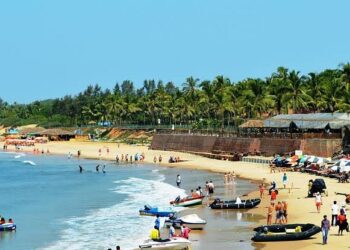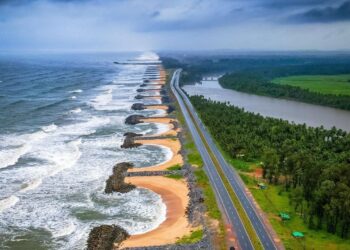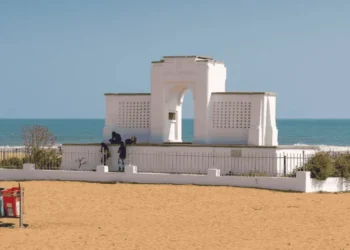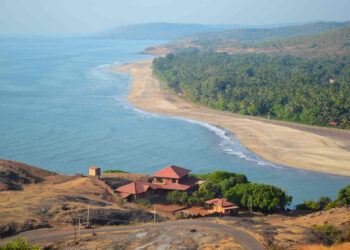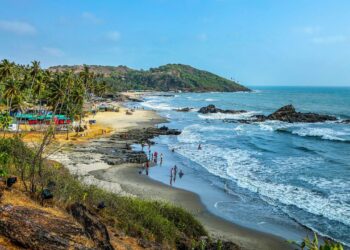Gorakhnath Temple sits near the Gorakhpur–Sonauli Highway in Gorakhpur, Uttar Pradesh. It is a sacred place where many people come to worship Guru Gorakhnath, a well-known saint of the Nath tradition. The temple is important to many followers who visit seeking peace and a connection to the spiritual history of the area. For the Nath community, this temple is both a place for prayer and a symbol of India’s long religious and cultural heritage.
History of Gorakhnath Temple
Often called Gorakhnath Math, the temple was built to honor Guru Gorakhnath. He is thought to have lived around the 11th or 12th century and helped spread the teachings of the Nath sect throughout India. He played a key role in spreading the teachings of the Nath tradition throughout India. He was instrumental in spreading the principles of the Nath Sampradaya throughout many parts of India. More than a place for worship, the temple grew into a centre of learning and spiritual practice. Through the years, it has preserved the teachings and path shown by Guru Gorakhnath and the line of yogis who followed him. Gorakhpur is named after him, as he is said to have practiced meditation here.
The temple’s present form took shape in the 19th century under Mahant Digvijaynath and Mahant Avaidyanath, though the site has been sacred for ages. Old tales say it faced attacks by Mughal rulers like Alauddin Khilji in the 14th century and Aurangzeb in the 18th century, but it stayed a holy spot. In Gorakhpur’s busy heart, the temple covers 52 acres and stands as a center for Nath ways. Priests and devotees keep it alive, with Yogi Adityanath, Uttar Pradesh’s Chief Minister, as its head. The temple’s story, tied to faith and yogic tradition, makes it a key place in the Nath Sampradaya.
Legends of Gorakhnath Temple
The temple is linked to tales of Guru Gorakhnath and Nath customs. One main story says Gorakhnath, a disciple of Matsyendranath, mastered Hatha Yoga here and gained great wisdom. Seen as a form of Lord Shiva, he is known for his meditation and teachings. Devotees believe chanting the Gorakhnath Chalisa 12 times brings blessings from the Divya Jyoti, a flame said to burn since Gorakhnath’s time.
Another tale ties the temple to Bhima, the Pandava from the Mahabharata. It is said Bhima came to invite Gorakhnath to a yagna but found him in deep meditation. While waiting, Bhima’s weight sank the ground, forming Bhimsarovar, a pond now used for boating. Local stories also say Gorakhnath came to Gorakhpur after seeking alms from Jwala Devi, leaving a legacy of spiritual practice.
Architecture of Gorakhnath Temple
The temple has a simple North Indian look with Nath sect touches. Made of stone, it has a tall shikhara and carved gates. The main shrine holds a white marble idol of Gorakhnath, sitting in a meditative pose, seen as a form of Shiva. His sacred footprints, called charan paduka, rest near his prayer seat, where he sat after his travels.
The temple’s large campus has open courtyards, a cow shed or Goshala, and small shrines for Shiva, Ganesha, Kali, and Bhairav. A gallery shows statues of the nine Naths, key figures in the Nath tradition. The Bhimsarovar pond lies to the east, its water tied to pilgrimage tales. The temple’s clean spaces and plain carvings of yogic symbols focus on spirituality, not show.
Visiting Information for Gorakhnath Temple
How to Get There
The temple is in Gorakhpur, 4.5 kilometers from Gorakhpur Railway Station. Ways to get there are:
By Air: Gorakhpur Airport, 8 kilometers away, links to Delhi, Varanasi, and Lucknow. Taxis or auto-rickshaws take 20 minutes to the temple.
By Rail: Gorakhpur Junction, 4.5 kilometers away, connects to Delhi, Varanasi, and Lucknow. Auto-rickshaws or taxis take 10–15 minutes to the temple.
By Road: Gorakhpur is 276 kilometers from Lucknow and 235 kilometers from Varanasi on NH 27. From the city bus stand, auto-rickshaws or taxis take 10 minutes. Parking costs ₹10, but spaces are few, so use public transport.
Temple Hours
The temple opens daily from 3:00 AM to 10:00 PM. Aartis are at 3:00 AM and 7:00 PM, with extra rituals during festivals like Makar Sankranti. Check with temple staff for festival times.
Best Time to Visit
September to February has cool weather, 15°C to 20°C, good for Gorakhpur. Makar Sankranti’s Khichdi Mela is lively but crowded. Summers, April to June, hit 39°C, so visit early. Monsoons, June to October, can make paths wet, so step with care.
Rules for Visitors
Wear proper clothes: men need shirts, trousers, or dhotis; women should wear sarees or churidar with a dupatta. No shorts or sleeveless tops.
Remove shoes before entering; storage is available for ₹2–5 per pair.
No photos inside; outside photos need priest permission.
Offerings like khichdi, sweets, or flowers are fine; speak to priests for special prayers.
No smoking, spitting, or alcohol. Eat prasad in the temple.
Bring water and a hat for open areas. Watch crowds during festivals.
Nearby Places
Railway Museum: 5 kilometers away, showing Gorakhpur’s rail history.
Gita Vatika: 6 kilometers away, a spiritual center with Krishna teachings.
Vishnu Mandir: 4 kilometers away, a temple for Lord Vishnu.
Ramgarh Taal: 7 kilometers away, a lake with boating and a planetarium.
Final Words
The Gorakhnath Temple in Gorakhpur was built to honor Guru Gorakhnath and serves as an important center for Nath teachings. Visitors to this holy city can experience the deep spiritual heritage of India. A visit to the temple offers a chance to feel the divine presence of Gorakhnath and connect with Gorakhpur’s ancient spiritual traditions, making it a must visit place in your travel list of temples.

